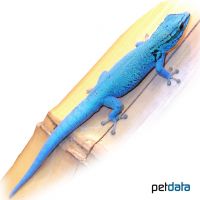Turquoise Dwarf Gecko (Lygodactylus williamsi)
| Turquoise Dwarf Gecko Lygodactylus williamsi | |
|---|---|
| Name | Turquoise Dwarf Gecko |
| Name Lat. | Lygodactylus williamsi |
| Family | Geckos |
| Family lat. | Gekkonidae |
| Order | Scaled Reptiles |
| Order lat. | Squamata |
| Origin | Tanzania |
| Habitat | Rainforests |
| Diet | Insects, fruits |
| Humidity | 70-90 % |
| Behavior | ♂ territorial |
| Keeping | Individual, pair, harem |
| Care Level | Experts only |
| Reproduction | Oviparous |
| Housing | Humid terrarium |
| Life Span | 5 years |
| Protection | CITES Appendix I; EU Annex A |
| Metric Units | |
| Size | 6 cm |
| Temperature | 26-28 °C |
| Temperature Local | 35 °C |
| Housing Size | 40 x 40 x 60 cm |
| US Units | |
| Size | 2.4" |
| Temperature | 79-82 °F |
| Temperature Local | 95 °F |
| Housing Size | 15" x 15" x 25" |
Distribution and habitat
The diurnal Williams dwarf geckos are found exclusively (endemically) in the Kimboza Forest Nature Reserve, in northeastern Tanzania, where they live primarily on screw trees (Pandanus).
Maintenance
Minimum dimensions for the terrarium, according to the size and number of animals
| 1-2 animals | 6KRL x 6KRL x 8KRL (L x W x H) |
Head-torso length (KRL) is measured on the largest animal. For each additional animal, increase the footprint by 15%. A terrarium of e.g. 40 x 40 x 60 cm is recommended, which should be placed in a quiet and vibration-free place.
You need a terrarium with partly vertical climbing branches (bamboo) and branch hollows as well as plants, like Ficus, Bromeliads, Scindapsus etc. (hiding and shadow places), structured back and side walls (e.g. cork lining), a substrate of forest soil-peat mixture and a water basin (waterfall). The substrate should always be kept slightly moist. Several times a day the inside of the terrarium should be finely sprayed with water (humidity), but a rain or mist system is better
| Temp. day: 26-28 °C | Temp. night: 20-24 °C | Temp. local: up to 35 °C | Humidity: 70-90 |
Thermostatically controlled floor heating is recommended. Lighting duration must be 12-14 hrs depending on the season. They need high light intensity and daily UV irradiation as well as sunny places with radiant heat.
Diet
The food supply consists of live insects, such as crickets, house crickets, grasshoppers, cockroaches, zophobas and mealybug larvae, alternatively special ready-made food for geckos or insectivorous reptiles can be offered, supplemented with some fruit pulp and sweet fruits (e.g. bananas, papaya). Wax moths should rarely be fed in very small amounts due to their large fat content. Young animals should be offered food daily, adults 4-5 times a week. Regular addition of minerals and vitamins (dusting of feed) is important. Drinking water must always be available, but is preferably taken in drop form from leaves or furnishings. A regular and varied diet promotes health and prevents deficiency symptoms.
Reproduction and breeding
The male is intensely blue in color, has a thickened tail root and clearly visible preanal pores. Non-dominant males are suppressed and do not develop beautiful coloration.
The female sticks her hard-shelled eggs (2 pieces) to the decoration. The incubation period is 50-70 days at a temperature of 28 °C. Small insects such as fruit flies and micro crickets are suitable as initial food for the young. The life expectancy can be 5 years.
Species protection
The animal population must be reported in writing to the competent authority immediately after the start of keeping. Your pet store will be happy to provide you with further information.
Species protection: WA Appendix I; EU Appendix A. You will receive a CITES document with the purchase, which confirms that this animal is an offspring. Please keep the CITES document in a safe place!
Important
They must not be held by their tails, which they can shed in case of danger. In most cases, no complete regeneration takes place.
Adult males are territorial and incompatible with each other. However, they can be kept in a group, one male with 2-3 females.
They are very sun-loving and need sunny places warmed up by radiators
For the resting phase, shorten the lighting duration by 2-3 hours and lower the temperature by 3-4 °C for about two months.
With fruit and honey water as food for the feeders, their quality can be upgraded.
The terrarium must have good ventilation without drafts and meet the species specific needs. Measuring devices such as thermometers, hygrometers, etc. are necessary. The lighting has to correspond to the species-specific day-night rhythm and has to be placed in such a way that the animals cannot injure themselves. The terrarium should be locked in such a way that neither unauthorized persons can open it nor the animals can escape. Contamination must be removed regularly.
Further literature can be found in your pet store.
References
Text: petdata; Image: petdata
Source: BMELV (1997): Tierschutzgutachten - Mindestanforderungen an die Haltung von Reptilien; RÖLL BEATE (2006): Zwerggeckos Lygodactylus, Natur und Tier-Verlag
- Gemäß § 21 Abs. 5 Tierschutzgesetz idgF
